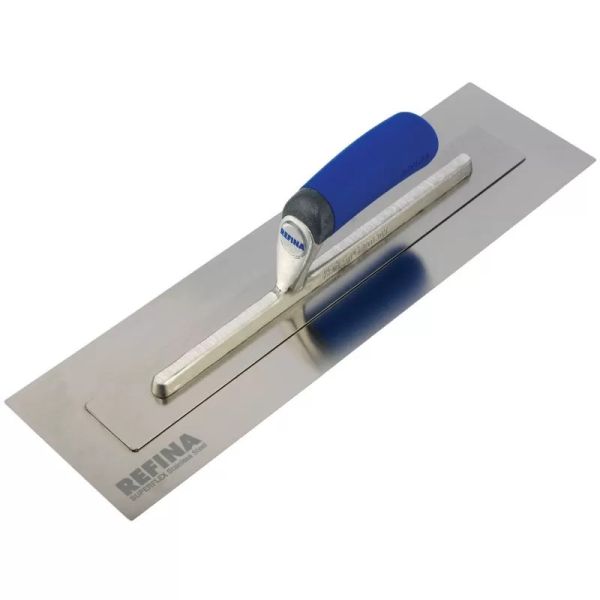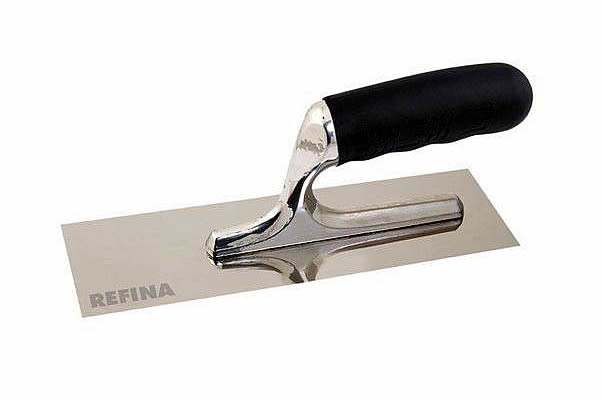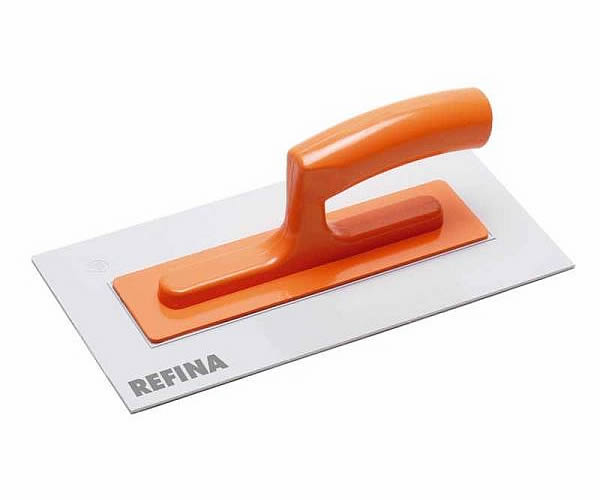Plastering Trowels: Essential Tools for Professional Finishes
The plastering trowel has long been a fundamental implement in the craft of plasterwork, traditionally serving 3 purposes: to apply, smooth, and perfect the plaster. Now, with a burgeoning array of trowel types entering the market, professionals and DIY enthusiasts alike are faced with the challenge of selecting the proper tool from an ever-growing arsenal; from trowels boasting flexible blades to those fashioned from synthetic materials, even extending to tools finished with a gold-like sheen, choosing the right trowels can be a bewildering process for the DIY enthusiast or for those new to the trade!
It’s crucial to discern the true utility of these tools against the allure of their innovative designs. Misapplication of a specialised trowel can not only hamper the finish but can actively degrade the quality of the plasterwork. Understanding when and why to utilise each type ensures a pristine result, steering clear of avoidable mishaps in what is both an art and a technical discipline.
Varieties of Plastering Trowels and Their Applications
Plastering projects necessitate the right type of trowel for optimum results. Flexi trowels, known for their adaptability, are preferred for their capacity to flex, which is particularly beneficial during the final stages of plastering to achieve a smooth finish. It is essential to select the correct trowel for the task to prevent flaws in the plasterwork.
- Standard Trowel: Ideal for the initial application of plaster, due to its rigid flat blade.
- Bucket Trowel: Used to scoop and spread plaster from the mixing bucket, featuring a wider and shorter blade.
- Corner Trowel: Designed to shape and smooth corners and angles with precision.
- Margin Trowel: A smaller tool used for mixing or patching tasks and accessing tight spaces.
Flexible Trowels

Flexible plastering trowels have revolutionised the plastering industry with their unique design tailored for the finishing stages of plasterwork. Crafted with a notably slimmer blade, they boast a remarkable degree of bend, which permits effortless and smooth application during the final touches of plastering.
Characteristics of Flexible Trowels:
- Thinner Blade: Promotes high flexibility.
- Ease of Use: Reduces strain on joints compared to traditional trowels.
- Efficient Finishing: Achieves a superior finish with less effort.
Unlike solid, conventional plastering trowels with stiff blades that assist in flattening and application, flexible trowels alleviate the physical stress that could lead to discomfort. The slim nature of the flexible trowel's blade not only makes the plastering process less laborious but also aids in achieving a flawless surface finish.
Renowned for their efficiency and ease of handling, these trowels have swiftly become indispensable tools for plasterers. It’s advised that they are exclusively used for their intended purpose – finishing, as they are not suited for initial application or preparation work. Their innovative design requires less time to become 'broken in', meaning they can be used to great effect straight away.
For professionals and DIY enthusiasts alike looking to enhance their plastering toolkit, the addition of a flexible trowel could be a significant step towards achieving impeccable results with minimal physical strain.
The BIG Problem With Flexible Trowels
Flexible trowels, despite their growing popularity among plastering tools, harbour a significant issue that often goes unnoticed: their propensity to create uneven surfaces. The suppleness of their blades, which is intended for finishing touches, is unsuitable for the initial application or smoothing of plaster. When used improperly for these tasks, they tend to produce walls with wave-like patterns or so-called "Zebra Stripes".
The undulations only become apparent under specific lighting conditions, striking the wall at certain angles, unveiling the imperfection in the plasterwork. It's a common pitfall, partly because the intricacies of proper trowel usage aren't widely disseminated within the trade community.
The key to leveraging the potential of flexible trowels lies in reserving them exclusively for the final stages of plastering. Below are examples of prominent flexible trowels:
- Refina Superflex
- Nela Flex: Highly regarded among flexible trowels
- Marshalltown Permaflex
Another group of flexible trowels presents a slightly broader range of use, demonstrating versatility in different stages of the plastering process. However, caution is advised to ensure their use aligns with appropriate plastering techniques.
Semi Flexibility Plastering Trowels

Semi flexibility plastering trowels are regarded as highly versatile tools in the plastering process. Their blades offer an optimal balance of stiffness, which is crucial during the early and intermediate stages of plaster application. Typically, a standard trowel is used for applying the initial coats of plaster and for the first levelling of the surface. However, the medium flex trowels come into play soon after, being ideal for subsequent stages of flattening and finishing.
Due to their moderately stiff blades, these trowels combine the advantages of firmer trowels with the adaptability of more flexible ones, making them particularly lightweight and favoured amongst professionals for delivering a superb finish. These trowels manage to maintain a significant degree of precision while still providing the agility needed for intricate plasterwork.
Some popular models include:
- Refina Superflex 2: Highly esteemed for its combination of flexibility and firmness.
- Nela Mediflex: Known for its medium flex blade that caters to various plastering phases.
- Refina Superflex 3: Offers an even firmer blade for those seeking additional control.
These trowels are often recommended for practitioners who require a tool that grants precision in plaster application and smoothing, without compromising on the final surface quality.
Standard Plastering Trowel

When undertaking a plastering job, the importance of a robust standard plastering trowel cannot be overstated. These traditional trowels, with their thicker alloy construction, are indispensable for applying and smoothing plaster to achieve flat surfaces. The density and strength of these trowels contribute to their efficacy in plastering tasks.
Though standard trowels are slightly heavier and require a longer period for the blade to wear in and sharpen—hence a smoother finish—they are fundamental to the plastering process. Their relative heaviness compared to more flexible options is a small trade-off for the flatness they provide to walls.
A classic choice in this category would be the Marshalltown Permashape trowel, renowned for its reliability in plaster application. Another worthy mention is the Nela Premium trowel, which also garners positive feedback from professionals.
Here's a brief guide on how they are typically used in a plastering sequence:
- Initial Coats: Apply the first and second layers of plaster using a standard trowel.
- First Leveling: For the initial smoothing, continue using the standard trowel.
- Subsequent Smoothing: Switch to a medium flex trowel for further flattening and finishing layers.
The adoption of such a process ensures that plasterers can create smooth and level surfaces effectively. Understanding the various trowel types available and their respective uses in the plastering process contributes significantly to achieving a professional finish.
Plastic Trowels

Plastic plastering trowels have emerged as a mainstay tool for plasterers, favouring a broad scope of applications throughout various plastering phases. Notable for their application flexibility, these tools aid in both spreading and finishing plaster with considerable ease.
They are impressively lightweight, due to being crafted from plastic, and are therefore a pleasure to operate. Among their many uses, their primary role often lies in executing the dry trowel stage, the ultimate finish that brings out the excellence of a plastered wall.
Such has been their impact that they are often cited as transformative within the plastering community. The consensus is that plastic trowels can elevate the quality of finish to outstanding levels, with visible improvements noted upon their introduction into the toolset.
As indispensable additions to a plasterer's toolkit, various models have garnered favour, including but not limited to:
- Refina Plaziflex – Highly regarded by professionals
- Nela Max
- Nela PlasticFLEX
Each of these trowels offers its distinct advantages, but collectively, they are lauded for their contribution to achieving a superior finish that is both smooth and uniform. For plasterers seeking to enhance their craftsmanship, the adoption of plastic trowels comes highly recommended.
Plastering Trowels - FAQs
What is the Main Function of a Plastering Trowel?
A plastering trowel is fundamentally used for the application of plaster onto surfaces such as walls and ceilings. Its primary role is to spread and smooth plaster uniformly, preparing it for further finishing and decoration.
Differences between Plastering Trowels and Finishing Trowels
Plastering trowels are designed with a wider and flatter blade for applying the initial coats of plaster. Finishing trowels, on the other hand, are utilised for the final coating, offering a smoother, more polished surface.
Features of a Professional Plastering Trowel
A top-notch plastering trowel showcases characteristics like a sturdy handle for a firm grip, a balanced weight for comfortable operation, and a quality stainless steel blade that provides resilience against corrosion and wear.
Considerations for Selecting a Suitable Plastering Trowel
When choosing a plastering trowel:
- Assess the blade size for the job's scale.
- Examine the trowel's handle for ease and comfort.
- Ensure the material's durability and longevity.
- Consider the blade's flexibility level for the desired finish.
Types of Trowels Used in Plastering
The types of trowels often used in plastering include:
- Standard trowel: For applying initial coats.
- Bucket trowel: To scoop and spread plaster from the bucket.
- Corner trowel: For shaping and defining corners and edges.
- Small trowel: For working on narrow spaces.
Maintaining a Plastering Trowel in Good Condition
To keep a plastering trowel well-maintained:
- Clean off excess plaster after each use.
- Store in a dry environment to prevent rust.
- Sharpen the blade regularly to ensure smooth application.
- Check for handle damage and repair as necessary.
